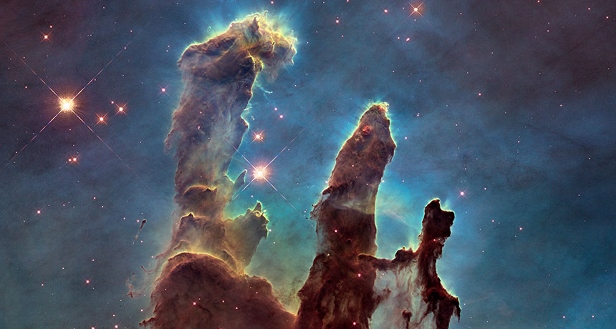Peering inside the Pillars of Creation
A new study explores how these iconic columns are influenced by the magnetic fields within them

The Pillars of Creation, as captured in a high-resolution HST image taken in 2014 as a tribute to the original Hubble photograph from 1995. Image credit: NASA/ESA/Hubble Heritage Team (STScI/AURA)
On 1 April 1995, Hubble captured one of its most well-known images: a stunning photo of towering features known as the Pillars of Creation, located in the Eagle Nebula just 7,000 light-years away. A new study explores how these iconic columns are influenced by the magnetic fields within them.
In the Hubble image, we see the result of young, hot stars that have driven a photoionization shock into the cloud around them, forming complex structures in the dense gas at the shock interfaces. These structures — in this case, dense columns of neutral gas and dust — are then bombarded with hot radiation from the young stars, giving the structures a misty, ethereal look as they photoevaporate.
Though astronomers have a rough picture, the specifics of how the Pillars of Creation were formed and how they evolve in this harsh radiation environment isn’t yet fully understood. In particular, the role of magnetic fields in shaping and sustaining these pillars is poorly constrained, both observationally and theoretically.
To address this problem, a team of scientists led by Kate Pattle of University of Central Lancashire, United Kingdom and National Tsing Hua University, Taiwan, has now made the first direct observations of the magnetic-field morphology within the Pillars of Creation.
Pattle and collaborators imaged the pillars as a part of the B-Fields in Star-Forming Region Observations (BISTRO) project, which uses a camera and polarimeter mounted on the James Clerk Maxwell Telescope in Hawaii. The high-resolution, submillimetre-wavelength polarimetric observations allowed the team to measure the orientations of the magnetic fields within the pillars.

BISTRO magnetic-field vectors have been observed in the Pillars of Creation, and are overlaid on a Hubble composite of the pillars. Image credit: Pattle et al. 2018
Pattle and collaborators found that the magnetic fields inside the Pillars of Creation are actually quite organised: they generally run along the length of the pillars, perpendicular to and decoupled from the field in the surrounding cloud. The authors use their observations to estimate the strength of the fields: roughly 170–320 micrograms in the pillars.
What do these results tell us? First, the strength of the fields is consistent with a formation scenario in which very weakly magnetised gas was compressed to form columns. The authors propose that the Pillars of Creation were formed when an ionisation front — driven by radiation from nearby young, hot stars — encountered a dense clump as it moved through the cloud of molecular gas. The overdensity slowed the front, causing the magnetic field to bend as the surrounding gas moved. The compressed magnetic field then supported the resulting column from collapse.
Pattle and collaborators argue that the magnetic fields in the Pillars of Creation are supporting the pillars radially against collapse even now. They may also be preventing the pillar ends from breaking off into disconnected clumps known as cometary globules, a process that could eventually disintegrate the pillars.
So what’s BISTRO up to now? The project is continuing to survey magnetic fields in the dense gas of other nearby high-mass star-forming regions. This may help confirm the results found for the Pillars of Creation, bringing us another step closer to understanding how magnetic fields influence the some of the striking features that Hubble and other telescopes have revealed in our astronomical backyard.
 Keep up to date with the latest reviews in All About Space – available every month for just £4.99. Alternatively you can subscribe here for a fraction of the price!
Keep up to date with the latest reviews in All About Space – available every month for just £4.99. Alternatively you can subscribe here for a fraction of the price!




